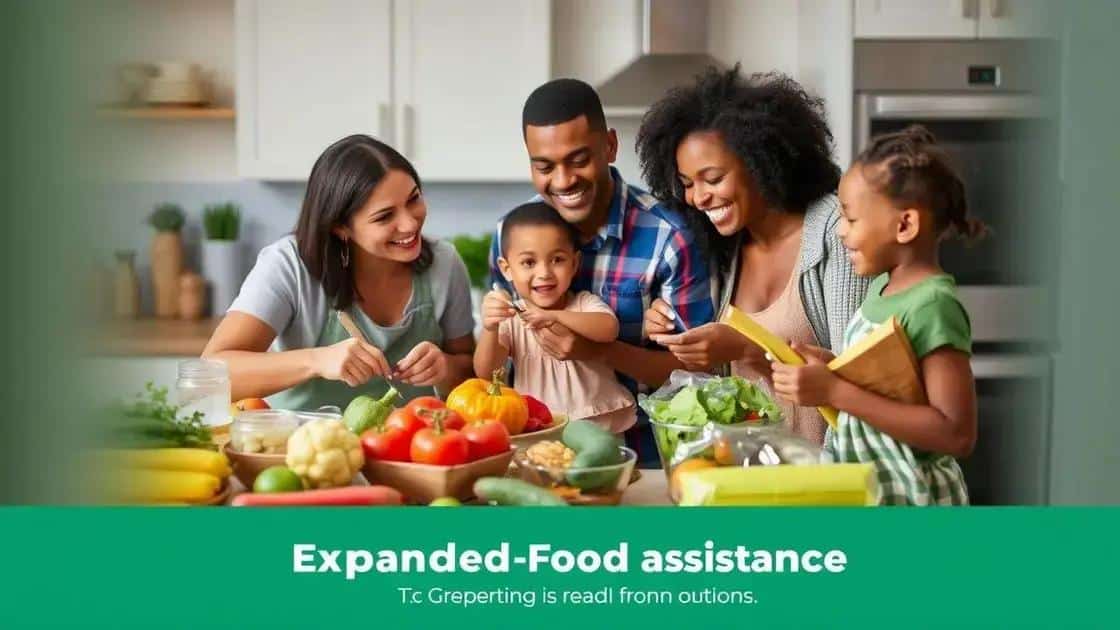How to apply for food assistance programs easily

To apply for food assistance programs, gather necessary documents like proof of income and residency, complete the application accurately, and be mindful of deadlines to increase your chances of approval.
How to apply for food assistance programs might seem daunting, but it doesn’t have to be. Many people are eligible for help, yet they might be unaware of the steps required. Are you one of them? Let’s simplify the process and explore how you can secure the support you deserve.
Understanding food assistance programs
Understanding food assistance programs is essential for anyone facing food insecurity. These programs are designed to help individuals and families access nutritious food, ensuring no one goes hungry. They can be a lifeline during tough financial times.
There are several types of food assistance programs available, each with different benefits and eligibility criteria. Two of the most common programs are the Supplemental Nutrition Assistance Program (SNAP) and local food banks. Let’s explore these options a bit more.
Basics of SNAP
SNAP, formerly known as food stamps, is a federal program that provides financial assistance to buy food. Eligibility often depends on household income, size, and expenses. Many families qualify and don’t realize it!
Local Food Banks
Local food banks also play a crucial role. They distribute food directly to those in need, no application required in many cases. Here’s what you should know:
- Food banks often have no income requirements.
- They operate on a first-come, first-served basis.
- Volunteers help gather and distribute food.
- They may provide other services, like cooking classes or nutrition education.
In addition to these programs, various charities and community organizations offer support. Understanding the various resources available can get you back on your feet during challenging times. Remember, you’re not alone in this journey.
How to Find Programs in Your Area
Finding food assistance programs can be as simple as a few clicks or a phone call. Start by checking local government websites. Many have searchable databases. You can also call local charities directly for information.
Keep in mind that each program may have specific requirements, so always check the eligibility criteria. Most importantly, don’t hesitate to reach out for help if you need it. Food assistance programs exist to ensure everyone can eat well and stay healthy.
Eligibility criteria for assistance
Eligibility criteria for food assistance programs can vary based on location and specific program guidelines. Understanding these criteria is crucial to accessing the support you need.
Most programs assess eligibility through factors such as income, household size, and expenses. For instance, families may need to demonstrate low income compared to their local area’s poverty guidelines.
Income Requirements
Income is one of the primary factors. Generally, programs consider gross income, which includes all earnings before deductions. For many assistance programs, the household income must be at or below a certain percentage of the federal poverty level.
Household Size
Household size plays a significant role in determining eligibility. The more people in your household, the higher your income threshold may be. Each program has specific charts to help determine what the maximum allowable income is based on family size.
- Single individuals often have lower income thresholds.
- Families with more members typically have higher limits.
- Always check your local agency for specific household size calculations.
Expenses can also affect your eligibility. Programs may consider necessary expenses like housing, childcare, and medical costs. If your expenses are high relative to your income, you may qualify even if you earn slightly more than the basic income cap.
In addition, some programs offer special provisions for the elderly or disabled individuals, providing additional flexibility in eligibility. Keep an eye out for local resources that can guide you through the application process.
Step-by-step application process

The step-by-step application process for food assistance programs may seem overwhelming, but breaking it down can make it easier. Knowing what to expect is the first step toward getting the help you need.
Before you start, gather necessary documents such as proof of income, identification, and any other relevant information about your household. Having this ready will streamline your application.
1. Find the Right Program
Begin by identifying which food assistance program fits your needs. Look online or contact local agencies for guidance. Depending on your location, options may vary.
2. Complete the Application
Once you’ve selected a program, complete the application form. This can often be done online, by mail, or in person. Make sure to fill out all sections accurately to avoid delays.
3. Submit Required Documents
Along with your application, you’ll need to submit documentation. This can include:
- Proof of income (pay stubs, tax returns)
- Identification (driver’s license, state ID)
- Proof of residency (utility bills, lease agreements)
Don’t forget to check if additional documents are required for your specific case.
4. Interview Process
Some programs may require an interview. This could be over the phone or in-person. They will ask questions about your household situation. Be honest and clear; this interview helps them assess your needs accurately.
5. Await the Decision
After submitting your application and completing any required interviews, you will receive a decision. This process can take from a few days to several weeks depending on the program’s workload.
If approved, you’ll receive information on how to access your benefits. If denied, you will be informed of the reasons and your right to appeal. Taking it step-by-step can help ensure your application is successful and your family gets the assistance needed.
Common mistakes to avoid
When applying for food assistance programs, it’s vital to avoid common mistakes that can delay your application or lead to a denial. Understanding these pitfalls can make the process smoother and ensure you get the help you need.
One of the biggest mistakes is not providing accurate information. Always double-check your income and household details. Small errors can raise red flags, causing your application to be flagged for further review.
Missing Documentation
Failing to submit required documents is another frequent issue. Each program has specific documentation requirements, and missing paperwork can stall your application. Remember to include:
- Proof of income.
- Identification numbers for all household members.
- Residency proof, like a lease agreement or utility bill.
It’s also important to keep copies of everything you send. This way, you have records in case there are questions or if something goes missing.
Ignoring Deadlines
Another common error is overlooking deadlines. Each program has a time frame for applications or renewals. Set reminders on your phone or calendar to ensure you don’t miss these critical dates.
Failing to Follow Up
After submitting your application, don’t forget to follow up. Contact the agency if you haven’t received a response within the expected timeline. Following up shows your interest and ensures your application is in progress.
Finally, don’t hesitate to ask for help. Many organizations, including community groups, offer guidance on completing your application. Utilizing their resources can help you avoid these common mistakes and increase your chances of success.
Resources for additional help
Many resources for additional help are available for those applying for food assistance programs. Knowing where to look can make a significant difference in simplifying your experience.
Start by visiting local food banks, which often have a wealth of information. They not only provide food but can also guide you through the application process for various programs.
Community Organizations
Many community organizations offer assistance with the application process. They may provide:
- Free consultations to discuss your needs.
- Workshops that explain how to apply for assistance.
- Access to resources like transportation or childcare during appointments.
Don’t hesitate to reach out to these groups, as they often have dedicated staff ready to help.
Online Resources
When seeking help online, numerous websites can provide valuable information. Websites like the USDA offer tools to determine eligibility and apply for programs. Additionally, state government websites usually have specific sections for food assistance.
Hotlines and Support Services
If you prefer speaking to someone directly, hotlines are also available that can answer your questions. Calling these can help clarify the application steps and requirements.
In many areas, local churches and nonprofits also have supportive programs to assist those in need. These organizations can provide food, counseling, or even legal help with applications.
Utilizing these resources can alleviate some of the stress of navigating food assistance. Don’t be afraid to seek help; many are ready to support you in getting the assistance you deserve.
Conclusion
Navigating food assistance programs can feel overwhelming, but knowing the steps and resources available makes it manageable. Focus on understanding the eligibility criteria, filling out applications carefully, and avoiding common mistakes. Remember, you are not alone in this journey; many community organizations and online resources are ready to help. Don’t hesitate to reach out for support, as these programs are designed to help you and your family access the food you need.
FAQ – Frequently Asked Questions about Applying for Food Assistance Programs
What documents do I need to apply for food assistance?
Typically, you will need proof of income, identification, and residency documents to complete your application.
How long does the application process take?
The application process can take anywhere from a few days to several weeks, depending on the program and your specific situation.
What should I do if my application is denied?
If your application is denied, you will receive a notice explaining the reasons. You have the right to appeal the decision.
Are there resources to help me with the application?
Yes, many community organizations and food banks offer assistance with the application process, so don’t hesitate to reach out for help.





